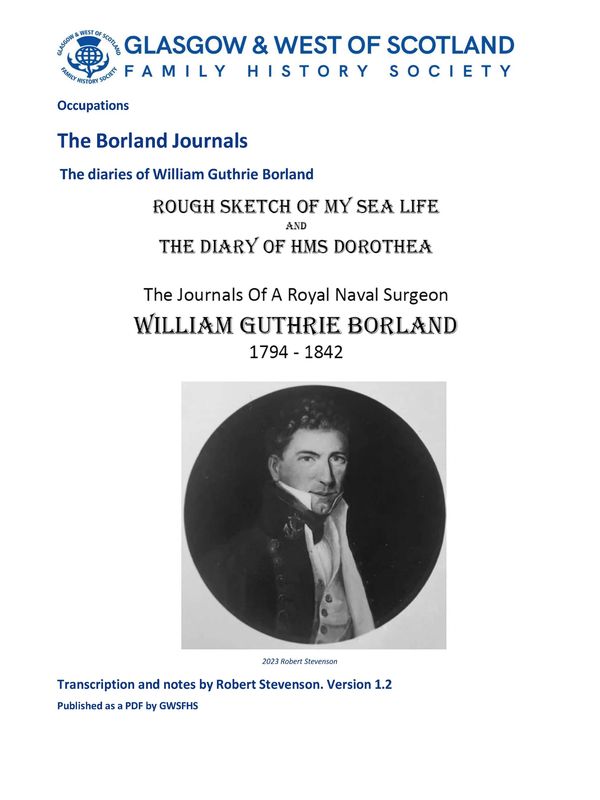My Other Publications
Stevens & Struthers
The Borland Journals
The Borland Journals
From a modest brass foundry in Glasgow to a cornerstone of Scotland’s shipbuilding and engineering history, Forged in Bronze tells the remarkable story of Stevens & Struthers. Founded in 1868 by John Steven and Wilson Struthers, this pioneering company supplied essential bronze castings, from ship propellers to lighthouse foghorns, for nearly a century.
Through historic records, personal accounts, and rare photographs, this book traces the rise and fall of a company that thrived during Glasgow’s golden age of industry, only to fade as shipbuilding declined. A must-read for history buffs, industrial heritage enthusiasts, and anyone fascinated by the people behind the machines that shaped a nation.
Introduction:
In the heart of 19th-century Glasgow, amid the clang of shipyards and the glow of molten metal, a legacy was forged. Stevens & Struthers was more than just a foundry—it was a testament to the ingenuity, craftsmanship, and perseverance that defined an era.
Founded in 1868 by John Steven and Wilson Struthers, the company grew alongside Glasgow’s booming maritime industry, producing everything from ship propellers to foghorns that still echo across the Scottish coast. At its peak, the foundry’s bronze castings played a crucial role in naval engineering, with its components found in vessels that sailed the world.
But like many industrial powerhouses, Stevens & Struthers faced the challenges of changing times. As the shipbuilding industry declined in the mid-20th century, so too did the demand for their specialized craftsmanship. In 1956, after nearly 90 years of innovation, the company was sold and its foundry doors closed for good.
This book is more than just a history of a company—it is a tribute to the men and women who worked the furnaces, shaped the metal, and built a legacy in bronze. Through newspaper clippings, personal letters, and industry records, Forged in Bronze brings their story to life, preserving a crucial chapter of Scotland’s industrial past.
Step into the foundry, hear the roar of the furnaces, and witness the rise and fall of a business that left its mark on Glasgow and beyond.
The Borland Journals
The Borland Journals
The Borland Journals

Step aboard the creaking decks of early 19th-century Royal Navy ships as seen through the eyes of William Guthrie Borland, a young Scotsman who joined the Navy as a surgeon in 1814. In this extraordinary collection of first-hand accounts—Rough Sketch of My Sea Life and The Diary of HMS Dorothea—Borland documents over two decades of service across the world’s oceans, from Arctic expeditions to encounters in South America, the Mediterranean, and the Chesapeake during the War of 1812.
Lovingly transcribed by Robert Stevenson, Borland’s distant relative, this book preserves not only the vivid detail of naval life but also the sharp observational wit and emotional candour of a man who witnessed history from the heart of the action. With battles, shipwrecks, pirates, epidemics, and even Napoleon’s captivity at St Helena, The Borland Journals is a rich trove for naval historians, family history enthusiasts, and lovers of real-life adventure alike.
Introduction:
On the 24th of March 1814, a 20-year-old Scotsman named William Guthrie Borland left his home in Kilmarnock and journeyed to London to begin a life at sea as a surgeon in the Royal Navy. His journey, launched aboard HMS Diadem, would span 23 years and crisscross the globe—from the battlefields of the War of 1812 to remote Arctic shores, from Mediterranean intrigue to the colonial outposts of the Americas.
William recorded this remarkable life in two handwritten accounts: Rough Sketch of My Sea Life, an ongoing record written during his service, and The Diary of HMS Dorothea, a retrospective narrative detailing an Arctic voyage. These writings offer an unfiltered glimpse into the professional, personal, and philosophical reflections of a naval surgeon navigating war, disease, shipwreck, and distant cultures.
As a distant relative descended from William’s sister Margaret, I undertook to transcribe these diaries for preservation and wider readership. Though he died without children, William left behind a legacy that reveals the resilience, curiosity, and intellect of a man shaped by service and exploration.
This volume collects and contextualises his writings, with added annotations and appendices for readers unfamiliar with early 19th-century naval life. What follows is a vivid portrait of a man and a time—courageous, challenging, and captivating.
